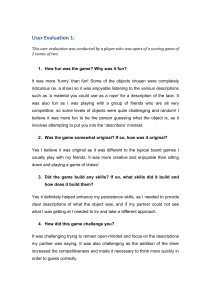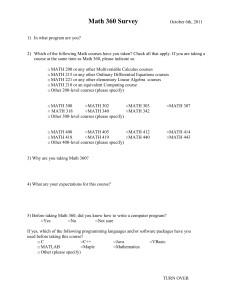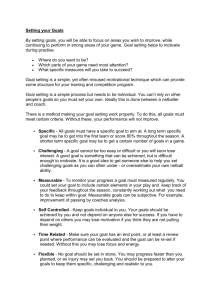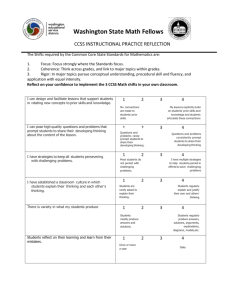Associate in Risk Management 54 Risk Assessment Exam Review
advertisement
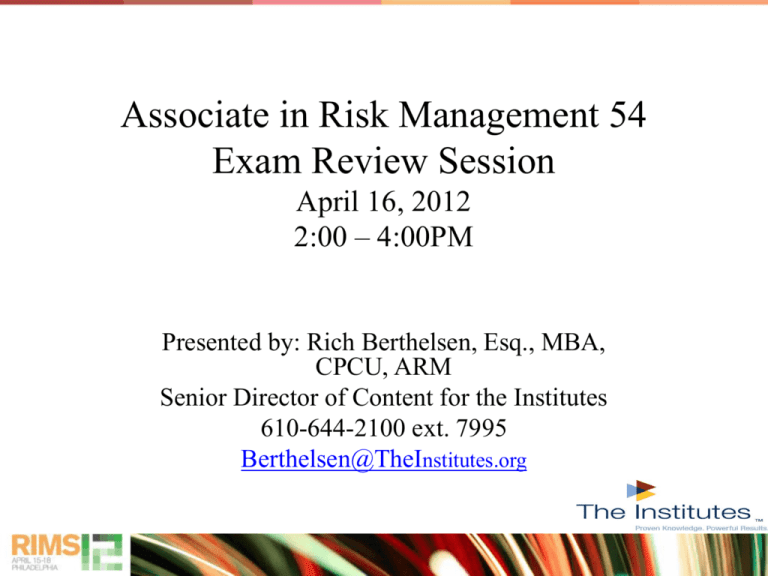
Associate in Risk Management 54 Exam Review Session April 16, 2012 2:00 – 4:00PM Presented by: Rich Berthelsen, Esq., MBA, CPCU, ARM Senior Director of Content for the Institutes 610-644-2100 ext. 7995 Berthelsen@TheInstitutes.org Overview What to Expect • • • • Exam experience Top 25 most challenging parts Disclaimer Practice exam questions per chapter are available on-line Challenging Part 1 – Ch.1 Earnings Stability Post-Loss Goals: Six possible post-loss goals include the following: 1. Survival 2. Continuity of operations 3. Profitability 4. Earnings stability 5. Social responsibility 6. Growth Challenging Part 1 – Ch.1 Earnings Stability Rather than strive for the highest possible level of profits (or surpluses, for not-for-profits) in a given period, some organizations emphasize earnings stability over time. Earnings stability requires precision in forecasting risk management costs, such as insurance or loss prevention. Challenging Part 2 – Ch.1 Internal Structure Risk Management Department Structure The head of the risk management department should assess the organization’s operations and the capabilities of the existing risk management staff to determine the proper internal structure that is needed. Challenging Part 2 – Ch.1 Internal Structure In small risk management departments, there may be only one person. The rate at which staff are added depends on the organization’s operations and its management’s attitudes about risk management’s role in the organization. Some organizations pride themselves on having minimal corporate staffing to serve decentralized branches or departments. Others prefer a large staff, centralized to perform many tasks for each branch or department. For a small risk management department, additions to personnel often begin with a safety and loss prevention manager and a claim manager. Challenging Part 2 – Ch.1 Internal Structure In medium-sized risk management departments, more assistance is required when: • insurance is used to finance risk • more complex aspects of safety and loss prevention emerge • volume of claims increase Challenging Part 2 – Ch.1 Internal Structure In large risk management departments, the director becomes less involved in implementing the technical aspects of risk management and more involved in managerial functions. The large department may also contain several positions in safety/loss prevention, health, and specialized claim personnel—some specializing in property claims, others in liability claims, and some in employee benefits. High frequency of particular types of retained losses, such as workers’ compensation claims or products liability claims, increases the need for specifically trained claim personnel. Challenging Part 3 – Ch.2 Financial Statements and Underlying Accounting Records Methods of Identifying Loss Exposures • Risk assessment questionnaires • Loss histories • Financial statements and underlying accounting records • Other records and documents • Flowcharts and organizational charts • Personal inspections • Expertise within and beyond the organization Challenging Part 3 – Ch.2 Financial Statements and Underlying Accounting Records Financial statements include: • A balance sheet is a statement of an organization’s financial condition as of a particular date. • An income statement (also called a profit and loss statement) is a financial report that shows the profit or loss for a specific period. • A statement of cash flows (also called the statement of changes in financial position or the statement of sources and uses of funds) is a financial statement that shows an organization’s cash receipts and cash payments during a specified period. Challenging Part 4 – Ch.2 Separation, Duplication, and Diversification Risk Control Techniques Risk control is a conscious act or decision not to act that reduces the frequency and severity of losses or makes losses more predictable. Risk control techniques include the following: • Avoidance • Loss prevention • Loss reduction • Separation, duplication, and diversification Challenging Part 4 – Ch.2 Separation, Duplication, and Diversification Separation is a risk control technique that disperses a particular asset or activity over several locations and regularly relies on that asset or activity as a part of the organization’s working resources. Duplication is a risk control technique that uses backups, spares, or copies of critical property, information, or capabilities and keeps them in reserve. Diversification is a risk control technique that spreads loss exposures over numerous projects, products, markets, or regions. Challenging Part 5 – Ch.3 Economic Value Methods of Valuing Property After indentifying the property exposed to loss, its value needs to be determined using one of these approaches: • Historical cost • Tax-appraised value • Book value • Replacement cost • Reproduction cost • Functional replacement cost • Market value • Actual cash value • Economic value Challenging Part 5 – Ch.3 Economic Value Economic value is the amount that property is worth based on the ability of the property to produce income. Unlike other valuation methods, economic value is not affected by the cost of the property or the expense that would be incurred to repair or replace it. Challenging Part 6 – Ch.3 Bailee’s Interest Legal Interests in Property Can be categorized as: • Ownership interest • Secured creditor’s interest • Seller’s and buyer’s interest • Bailee’s interest • Landlord’s interest • Tenant’s interest Challenging Part 6 – Ch.3 Bailee’s Interest A bailee is a person or entity who receives property from another (the bailor) under a bailment contract. A bailment contract requires the bailee to keep the property in safekeeping for a specific purpose and then to return the property to the bailor when the purpose has been fulfilled. Bailments frequently arise in business transactions involving repair, storage, or transport of personal property. Challenging Part 7 – Ch.4 Elements of Negligence Legal Liability Based on Torts A tort is a wrongful act or omission, other than a crime or breach of contract, for which the remedy is money. Torts can be classified into three types: (1) negligence, (2) intentional torts, and (3) strict liability torts. Negligence is the failure to exercise the degree of care that a reasonably prudent person would have exercised under similar circumstances to avoid harming another. Challenging Part 7 – Ch.4 Elements of Negligence A plaintiff must prove all four elements of negligence: 1. The defendant owed a legal duty of care to the plaintiff. 2. The defendant breached the legal duty of care owed to the plaintiff. 3. The defendant’s breach of duty was the proximate cause of the plaintiff’s injury or damage. 4. The plaintiff suffered actual injury or damage. Challenging Part 8 – Ch.5 Legal Duty Owed Basis for Premises and Operations Liability The basis for this liability usually stems from negligence. Property owners and occupiers (renters) have a legal duty owed to other persons on the premises. Challenging Part 8– Ch.5 Legal Duty Owed The degree of care a property owner or occupier owes to others depends on their reason for being on the property. Individuals who enter onto the property of others fall into one of three categories: 1. Business invitees 2. Licensees 3. Trespassers Challenging Part 8 – Ch.5 Legal Duty Owed A business invitee is an individual who has permission to be on the property of another for the purpose of doing business. Business invitees are owed the highest degree of care. It is not sufficient simply to warn the invitee of unsafe conditions. The law requires a reasonable effort to discover and correct hazardous conditions before they cause injury. Discovery of a hazardous condition can be by actual or constructive notice. Challenging Part 8 – Ch.5 Legal Duty Owed A licensee is an individual who has permission to go onto the property of another for his or her own purposes. Although licensees have permission to be on the property they do not necessarily have a specific invitation. Licensees generally must accept the condition of the property as it exists, and are owed a degree of ordinary care, such as warnings of known dangers. Challenging Part 8 – Ch.5 Legal Duty Owed A trespasser is an individual who intentionally goes onto the property of another without permission or any legal right to do so. The only duties owed to trespassers are to not intentionally harm them. Generally, a trespasser assumes the risks inherent in entering the land, except: • When young children are lured onto the land by an attractive nuisance • When the land possessor knows and tolerates trespassers Challenging Part 9 – Ch.5 Breach of Warranty Products Liability Loss Exposures Arise out of injuries or damage that result from a defective product. The liability loss exposures faced by product manufacturers, distributors, and sellers arise from the following three sources: 1. Breach of warranty 2. Negligence 3. Strict liability in tort Challenging Part 9 – Ch.5 Legal Duty Owed Breach of warranty - The failure to adhere to an express or implied warranty regarding the title, quality, content, or condition of the goods sold. Implied warranty - An obligation that the courts impose on a seller to warrant certain facts about a product even though not expressly stated by the seller. Implied warranty of merchantability - An implied warranty that a product is fit for the ordinary purpose for which it is used. Challenging Part 9 – Ch.5 Legal Duty Owed Implied warranty of fitness for purpose - An implied warranty that a product is fit for a particular purpose; applies if the seller knows about the buyer’s purpose for the product. Express warranty - A statement or representation about a product’s quality or suitability for its intended use. Challenging Part 10 – Ch.6 Persons and Employments Covered Employers’ Liability Under Statutes The following features in the U.S. workers’ compensation laws affect the scope of workers’ compensation loss exposures: • Choice of law •·Persons and employments covered • Injuries and diseases covered • Benefits provided • Procedures for obtaining benefits Challenging Part 10 – Ch.6 Persons and Employments Covered As a general rule, an employer’s legal obligations for occupational injury or disease extend to employees only, not to independent contractors. Challenging Part 10 – Ch.6 Persons and Employments Covered • An employee is one the employer fixes the hours of employment, provides the tools to do the work, and supervises the results of the work, as well as the methods and means of doing the work. • An independent contractor is one the employer does not typically fix the hours of employment and may provide the tools to do the work. The employer defines the results of the work but does not supervise the methods and means of doing the work. Challenging Part 10 – Ch.6 Persons and Employments Covered Exception to the general rule is a statutory employee which is an independent contractor’s employee who, because the independent contractor has not maintained workers’ compensation insurance, is considered to be an employee of the principal employing the independent contractor. Challenging Part 11 – Ch.6 Statute Environmental Liability Causes of Loss An organization can incur environmental liability under tort, contract, or statute. Challenging Part 11 – Ch.6 Statute The majority of environmental statutes regulate materials that are reactive, corrosive, toxic, or flammable. These statutes contain provisions that can lead to injunctions, fines, and other penalties for noncompliance, such as revocation of permits and criminal prosecution of corporate officers. Challenging Part 11 – Ch.6 Statute Continued on next 2 slides Challenging Part 11 – Ch.6 Statute Continued on next slide Challenging Part 11 – Ch.6 Statute Challenging Part 12 – Ch.7 Duty of Care Directors and officers have the duty of care (also called the duty of diligence) in the performance of their corporate functions. A definition of “duty of care” is that directors must discharge their duties with the care that a person in a like position would reasonably believe appropriate under similar circumstances. Challenging Part 12 – Ch.7 Duty of Care Business judgment rule is a legal rule that provides that a director will not be personally liable for a decision involving business judgment, provided the director made an informed decision and acted in good faith. Challenging Part 13 – Ch.7 Duties and Liabilities of Employee Benefit Plan Fiduciaries Employee Retirement Income Security Act of 1974 (ERISA) The federal law that governs retirement and other benefit plans. It was enacted in response to abuses and underfunding in many benefit plans. Challenging Part 13 – Ch.7 Duties and Liabilities of Employee Benefit Plan Fiduciaries • Care. ERISA specifies that a fiduciary must act with the care, diligence, and skill that would be exercised by a reasonably prudent person in the same or similar circumstances. • Loyalty. A fiduciary must act in the best interests of the plan and all of its participants and beneficiaries. • Diversification. A fiduciary must ensure that the plan’s investments are sufficiently diversified to minimize the risk of large losses. • Obedience. A fiduciary must act according to the plan documents and applicable law. Challenging Part 14 – Ch.8 Value Maximization and Social Responsibility Role of Corporate Governance Shareholders of for-profit corporations generally want managers to make risk management and other decisions that maximize the value of their shares, which in turn generally requires maximization of the corporation’s total economic value. Challenging Part 14 – Ch.8 Value Maximization and Social Responsibility Role of Corporate Governance In part because of corporate scandals, increased media and regulatory attention has focused on whether the goal of maximizing a corporation’s economic value (value maximization) appropriately serves the overall interests of society. Challenging Part 15 – Ch.8 Corporate Financial Reporting Key Issues in Corporate Governance Five corporate governance issues that affect long-term economic value creation: 1. Pressures from shareholder expectations and behavior 2. Executive incentives and compensation 3. Accountability of directors 4. Corporate financial reporting 5. Importance of integrity Challenging Part 15 – Ch.8 Corporate Financial Reporting Corporate Financial Reporting is concerned with the extent external (independent?) auditors of corporate financial reports accommodated deceptive reporting practices in recent corporate scandals. Also, is the U.S. rules-based accounting system preferable to principles-based systems practiced in the United Kingdom? Challenging Part 16 – Ch.9 Trends Affecting Personnel Loss Exposures Forecasting personnel losses requires attention to demographic trends that affect employee morbidity, mortality, retirement, or employee separations. One of the most significant demographic trends in the U.S. is the aging of the population, particularly the baby boomers. Challenging Part 16 – Ch.9 Trends Affecting Personnel Loss Exposures Continued on next slide Challenging Part 16 – Ch.9 Trends Affecting Personnel Loss Exposures Challenging Part 17 – Ch.10 Financial Consequences of Business Interruption To assess the financial consequences of a net income loss from a business interruption, a risk management professional should consider the following factors that affect the severity of a net income loss: 1. Length of business interruption 2. Degree of business interruption 3. Changes in revenues 4. Changes in expenses 5. Restoration to normal income Challenging Part 18 – Ch.10 Methods of Assessing Net Income Loss Exposures The methods for assessing any loss exposure (see Slide 9) are also useful in assessing an organization’s net income loss exposures. The methods are as follows: 1. Risk assessment questionnaires 2. Loss histories 3. Financial statements and underlying accounting records 4. Other records and documents 5. Flowcharts and organizational charts 6. Personal inspections 7. Expertise within and beyond the organization Challenging Part 19 – Ch.11 Trend Analysis Trend Analysis identifies patterns in past losses and then projects these patterns into the future. The two most common types of trend analysis are time trends and regression analysis. Challenging Part 20 – Ch.11 Regression Analysis • Regression analysis definition: “A statistical technique used to estimate relationships between variables” • Why calculate it? To find the equation for the line that best fits the data points and to project this line to forecast the number of future losses. • How to calculate it? y = a + bx Challenging Part 20 – Ch.11 Regression Analysis The equation for regression analysis is y = a + bx y = the dependant variable, which is the variable being forecast (losses). x = the independent variable, which is the variable that determines the value of the variable being forecast (years) a = the y intercept b = the slope Challenging Part 20 – Ch.11 Regression Analysis Continued on next slide Challenging Part 20 – Ch.11 Regression Analysis Challenging Part 20 – Ch.11 Regression Analysis Challenging Part 21 – Ch.12 Alternative Probabilities An alternative probability is the probability that any one of two or more events will occur within a given period. The formula for calculating alternative probabilities is determined by whether the events involved are mutually exclusive or non-mutually exclusive. Challenging Part 22 – Ch.12 Mutually Exclusive Events For mutually exclusive events, the probability that any one of them will occur is the sum of their separate probabilities: p(A or B) = p(A) + p(B). For example, the probability of rolling either a three or a five on one roll of one die is: p(3 or 5) = 1/6 + 1/6 = 2/6 (or 1/3). Challenging Part 23 – Ch.12 Non-Mutually Exclusive Events When two events can occur at the same time, they are not mutually exclusive. The probability that at least one, and possibly both of them, will occur is the sum of their separate probabilities minus the joint probability that they will both occur, this can be expressed as: p(A or B or both) = p(A) + p(B) – p(A and B). Challenging Part 23 – Ch.12 Non-Mutually Exclusive Events For example, the probability of drawing a five from a deck of cards is 1/13, the probability of drawing a club is 1/4, and the probability of drawing the five of clubs is 1/52. Therefore, the probability of drawing a five or a club is calculated as: p(five or club) = p(five) + p(club) – p(five and club) = 1/13 + 1/4 – 1/52 = 4/52 + 13/52 – 1/52 = 16/52 = 4/13. Challenging Part 24 – Ch.13 Net Present Value (NPV) Method • • • Net present value definition: “The present value of all future net cash flows (including salvage value) discounted at the cost of capital, minus the cost of the initial investment, also discounted at the cost of capital.” Or stated another way: NPV = PV (sum of future net cash flows) – (initial investment) Why calculate it? Ranking capital investment proposals How to calculate it? See remaining slides for this challenging part. Challenging Part 24 – Ch.13 Net Present Value (NPV) Method Find the: 1. Amount of initial investment 2. Useful life of asset invested in 3. Differential annual after-tax cash flow 4. Minimum acceptable rate of return 5. Salvage value Continued on next slide Challenging Part 24 – Ch.13 Net Present Value (NPV) Method 6. Present value of all differential cash in flows: - if equal inflows each year use the PVF in Appendix B, p.13.34 - if unequal inflows each year use a different PVF per year in Appendix A, p. 13.32 7. Subtract the initial investment from the present value of all differential inflows (is the result positive or negative?) Challenging Part 24 – Ch.13 Net Present Value (NPV) Method Continued on next slide Challenging Part 24 – Ch.13 Net Present Value (NPV) Method Challenging Part 25 – Ch.14 Considering Uncertainty in Cash Flow Analysis • What happens if the risk management professional must account for costs that cannot be measured with much precision but are expected to reduce future cash flow? You have the cost of uncertainty • Why calculate it? To give management a more complete estimate of a proposal's cost. Challenging Part 25 – Ch.14 Considering Uncertainty in Cash Flow Analysis • How to calculate it? 1. Assign a subjective estimate of the cost of uncertainty to each risk management technique 2. Deduct the assigned cost of uncertainty from the after-tax net cash flow 3. Calculate the NPV and the IRR using the net cash flow adjusted for the assigned costs of uncertainty Challenging Part 25 – Ch.14 Considering Uncertainty in Cash Flow Analysis Continued on next 2 slides Challenging Part 25 – Ch.14 Considering Uncertainty in Cash Flow Analysis Continued on next slide Challenging Part 25 – Ch.14 Considering Uncertainty in Cash Flow Analysis Wrap Up Questions? • Ask me now before you leave or • Call 610-644-2100 ext.7995 or • Email Berthelsen@TheInstitutes.org If you had fun tell your friends.

